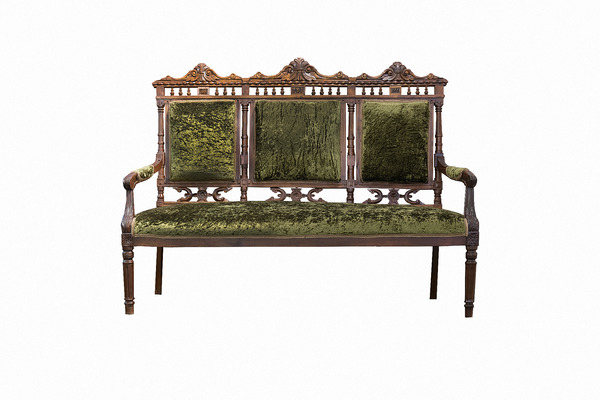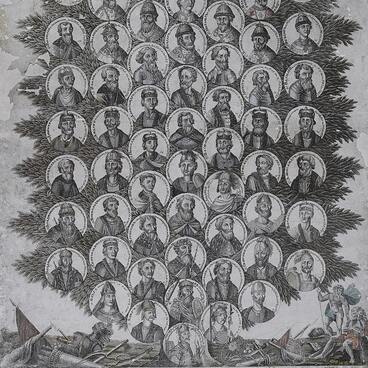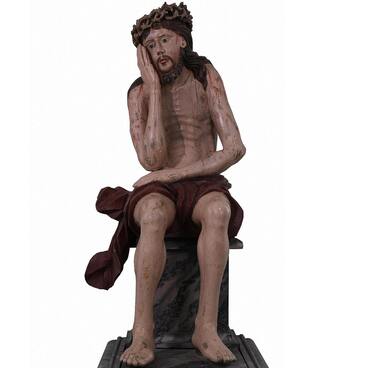The Russian word “divan” meaning “a sofa” appeared no later than the 19th century and first meant in Turkish and Arabic “bundle of written sheets” or “lists”. Then this word was used to denote registries and, eventually, the furniture found in such institutions — long benches with soft padding.
In the Russian Empire, divans began to spread in the mid-18th century — a large sofa with a big upholstered seat became especially popular.
The divan from the museum’s collection was created in the late 19th — early 20th century. It was donated by one of the Kargopol families. The furniture used to belong to the Isayev couple — Foma and Anna. In 1902, they moved from the village of Lyokshma to Kargopol. There they bought a house on Naberezhnaya Street. Most likely, at the same time, they also purchased a set of furniture: chairs, an armchair and a sofa.
Foma Isayev was hired by the merchant Nikolay Serkov. At first, he was a handyman, then from 1906 to 1914, he worked as a salesman. Foma’s son Nikolay was born in Kargopol. Throughout his life, he worked at financial institutions and lived in his parents’ house. Until recently, Foma’s granddaughter Marina Vasina also lived there. Nowadays, she works as a physics teacher at school No. 2.
When Marina Vasina and her husband were building a new house on the site, they decided to demolish the old one and donate the furniture and other antique items to the museum. The funds received documents and photographs of the Isayev family, antique Christmas decorations, household items and a set of furniture.
Unfortunately, the century-old furniture by that time was worn out and began to deteriorate. The sofa has only preserved its back and one leg. In 2012, when inspecting the collection, Alexey Chekin, a wood restorer at the Arkhangelsk branch of the All-Russian Scientific Restoration Center, agreed to restore it.
The sofa lacked two front legs, armrests and seats. The carving split off in many places, while its surviving fragments were a bit loose. When the restorer got to work, he discovered that the previous owners had repaired the piece more than once: numerous nail holes remained on the edges and there were nails in the soft parts. The backrest also showed signs of a low-quality reupholstery.
During the restoration process, the master carefully strengthened the time-worn parts, renovated the wood carvings and recreated the armrests, legs and seat. He also matched the new fabric and braid on the back and seat to the very first upholstery. All this enabled to recreate the original look of the entire set of furniture from the Isayev family.
In the Russian Empire, divans began to spread in the mid-18th century — a large sofa with a big upholstered seat became especially popular.
The divan from the museum’s collection was created in the late 19th — early 20th century. It was donated by one of the Kargopol families. The furniture used to belong to the Isayev couple — Foma and Anna. In 1902, they moved from the village of Lyokshma to Kargopol. There they bought a house on Naberezhnaya Street. Most likely, at the same time, they also purchased a set of furniture: chairs, an armchair and a sofa.
Foma Isayev was hired by the merchant Nikolay Serkov. At first, he was a handyman, then from 1906 to 1914, he worked as a salesman. Foma’s son Nikolay was born in Kargopol. Throughout his life, he worked at financial institutions and lived in his parents’ house. Until recently, Foma’s granddaughter Marina Vasina also lived there. Nowadays, she works as a physics teacher at school No. 2.
When Marina Vasina and her husband were building a new house on the site, they decided to demolish the old one and donate the furniture and other antique items to the museum. The funds received documents and photographs of the Isayev family, antique Christmas decorations, household items and a set of furniture.
Unfortunately, the century-old furniture by that time was worn out and began to deteriorate. The sofa has only preserved its back and one leg. In 2012, when inspecting the collection, Alexey Chekin, a wood restorer at the Arkhangelsk branch of the All-Russian Scientific Restoration Center, agreed to restore it.
The sofa lacked two front legs, armrests and seats. The carving split off in many places, while its surviving fragments were a bit loose. When the restorer got to work, he discovered that the previous owners had repaired the piece more than once: numerous nail holes remained on the edges and there were nails in the soft parts. The backrest also showed signs of a low-quality reupholstery.
During the restoration process, the master carefully strengthened the time-worn parts, renovated the wood carvings and recreated the armrests, legs and seat. He also matched the new fabric and braid on the back and seat to the very first upholstery. All this enabled to recreate the original look of the entire set of furniture from the Isayev family.



